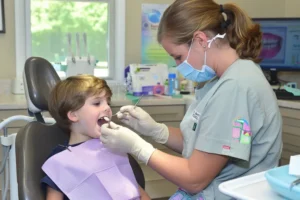Dental sealants offer a potent preventive measure against tooth decay, providing an extra layer of protection, especially in children. They work by creating a protective shield over the enamel of each tooth, particularly the back teeth, which are more susceptible to cavities due to their grooves and hard-to-reach location. By applying a liquid resin that hardens into a durable coating, sealants effectively block food particles and bacteria that promote cavities, thereby maintaining your child’s oral health. This treatment is quick, painless, and can significantly reduce the occurrence of cavities in children, contributing to maintaining strong and healthy teeth during their formative years.
“`htmlWhat Are Dental Sealants?
Dental sealants are a preventative dental treatment designed to protect teeth, particularly the molars and premolars, from decay. These sealants act as a barrier, shielding the teeth from bacteria and plaque that can cause cavities. They are most commonly applied to children and teenagers, who are at higher risk for cavities, but they can also benefit adults.
Applying dental sealants is a quick and pain-free process. A thin, protective coating—usually made from plastic or other dental materials—is painted onto the chewing surfaces of the teeth. This coating bonds into the depressions and grooves, forming a protective shield over the enamel of each tooth. By sealing out food particles and bacteria, dental sealants can significantly reduce the occurrence of tooth decay.
Studies have shown that dental sealants can reduce the risk of decay in molars by nearly 80%. This makes them an essential tool in preventative dentistry. Regular check-ups and cleanings at the dentist’s office help maintain the effectiveness of the sealants and ensure they last as long as possible.
Definition of Dental Sealants
Dental sealants are thin, plastic coatings that are applied to the chewing surfaces of the back teeth—most commonly the molars and premolars. The sealants are designed to cover the grooves and fissures in these teeth, which are particularly prone to decay because they can trap food particles and bacteria. The application of dental sealants is particularly recommended for children and adolescents. However, adults who do not have decay or fillings in their molars can also benefit from them. The Centers for Disease Control and Prevention (CDC) states that sealants can protect against 80% of cavities for up to two years after application, and continue to protect against 50% of cavities for up to four years.
Dental sealants are part of a comprehensive approach to dental health that includes regular brushing, flossing, and professional cleanings. They are a proactive measure rather than a reactive one, aiming to prevent dental issues before they start.
How Dental Sealants Work
Dental sealants work by creating a smooth, protective layer over the enamel of each tooth. When applied, the sealant material flows into the microscopic grooves and pits of the tooth surface, effectively sealing them off from bacteria and plaque.
The procedure to apply sealants is straightforward and painless. The teeth are first cleaned thoroughly to remove all plaque and food particles. Then, an acidic solution is applied to the chewing surfaces to roughen them up slightly, which helps the sealant bond to the teeth. After rinsing and drying the teeth, the liquid sealant is painted onto the tooth enamel, where it quickly hardens and forms a protective shield.
Sealants are especially beneficial for the molars and premolars because these teeth have more grooves and pits. By covering these vulnerable areas, sealants significantly reduce the risk of cavities and tooth decay. Regular dental check-ups ensure that the sealants remain intact and effective.
Types of Dental Sealants
There are two main types of dental sealants: resin-based sealants and glass ionomer sealants. Each type has its own advantages and is suitable for different needs and situations.
Resin-based sealants are the most commonly used type. They are known for their durability and their ability to create a strong bond with the tooth enamel. These sealants typically last longer and are the preferred choice for sealing the chewing surfaces of molars and premolars.
Glass ionomer sealants, on the other hand, are often used when durability is not the primary concern. These sealants release fluoride, which can help to strengthen the enamel and protect against decay. They are particularly useful in situations where moisture control is difficult, as they can bond to slightly moist surfaces.
Choosing the right type of sealant depends on various factors, including the patient’s age, dental history, and specific needs. A dentist will assess these factors and recommend the most appropriate type of sealant for optimal protection against dental decay.
To learn more about the latest advancements in dental care and preventative treatments, check out our other articles. Stay informed and keep your smile healthy!
“` “`html
Benefits of Dental Sealants
Dental sealants are a highly effective preventive measure in modern dentistry. They provide a protective barrier on the surfaces of the teeth, primarily molars and premolars, where decay often starts. Numerous studies have demonstrated that dental sealants can reduce the risk of decay by nearly 80%. This is particularly important for children and teenagers, who are most susceptible to cavities.
One of the primary benefits of dental sealants is their ability to provide long-lasting protection against tooth decay. Sealants are made of durable materials that can withstand the pressures of chewing and biting, often lasting for several years before needing reapplication. This means they offer a cost-effective solution for families looking to prevent dental issues in their children’s formative years. Additionally, sealants are easy to apply and painless, making them an ideal preventive measure that can be completed in a single dental visit.
Furthermore, dental sealants are not just for children. While they are most commonly applied to young patients, adults can also benefit from the application of sealants, especially those who are prone to decay or have deep grooves in their teeth. By preventing cavities, dental sealants help in maintaining overall oral health, reducing the need for more invasive and costly treatments like fillings, crowns, or root canals. Consequently, they play a significant role in promoting a lifelong healthy smile.
“`
Application Process of Dental Sealants
Dental sealants are a highly effective preventive measure against cavities, especially in children and teenagers. The process involves applying a thin, plastic coating on the chewing surfaces of the back teeth (molars and premolars). This coating helps to protect enamel from plaque and acids, significantly reducing the chances of decay. Numerous studies have shown that dental sealants can reduce the risk of decay in molars by nearly 80%. In this article, we will explore the application process, including preparation, the steps involved, and post-application care.
Understanding the application process of dental sealants can help patients and guardians make informed decisions about oral healthcare. It also emphasizes the importance of professional application by a dentist to ensure effectiveness and longevity. The following sections will detail each stage of the process to provide a comprehensive guide.
Preparation for Application
Before applying dental sealants, the teeth must be thoroughly cleaned. This preparation step ensures that any plaque or food particles are removed, providing a clean surface for the sealant to adhere to. Typically, a dental hygienist or dentist will clean the teeth using a rotating brush and a gritty toothpaste. This step is crucial because any debris left on the teeth can interfere with the sealant’s bonding process.
Once the teeth are cleaned, they are dried using a stream of air. A piece of cotton or an absorbent material may be placed around the teeth to keep them dry. Isolation of the teeth is essential to prevent saliva from contaminating the area where the sealant will be applied. Saliva can cause the sealant to not bond properly, compromising its effectiveness.
Finally, the dentist will apply an acid solution to the chewing surfaces of the teeth. This solution, known as an etchant, roughens the tooth surface, allowing the sealant to bond better. The etchant is left on the teeth for a specified period and then rinsed off thoroughly. After etching, the teeth are dried again to ensure they are ready for the sealant application.
Steps in the Application Process
Once the teeth are prepared, the actual application of the dental sealant begins. The dentist will apply the sealant material to the grooves and pits of the teeth’s chewing surfaces. This is typically done using a small brush or applicator. The sealant is in liquid form when applied, allowing it to flow into the grooves and pits effectively.
After the sealant is applied, a special curing light may be used to harden the material. This process is known as polymerization. The curing light, usually a blue LED, is placed over the sealant for a few seconds, causing it to harden and form a protective shield over the tooth.
The dentist will then examine the sealant to ensure it has properly adhered and hardened. They may use an instrument to check for any soft spots or areas where the sealant may not have bonded correctly. If necessary, additional sealant can be applied and hardened.
Finally, the dentist will evaluate the patient’s bite to ensure that the sealant does not interfere with normal chewing. If any adjustments are needed, they will be made at this time. Once the dentist is satisfied with the application, the process is complete, and the patient can leave with their newly protected teeth.
Post-application Care
Caring for teeth after the application of dental sealants is relatively straightforward. It is important to maintain good oral hygiene practices, including brushing twice a day and flossing daily. Although sealants provide an additional layer of protection, they do not replace the need for regular brushing and flossing. Patients should also continue to visit their dentist for regular check-ups and cleanings.
Patients are advised to avoid chewing on hard objects such as ice or hard candies, as these can potentially damage the sealants. While sealants are durable, they are not indestructible, and excessive force can cause them to chip or wear away.
In some cases, the dentist may recommend a fluoride treatment in addition to sealants. Fluoride can help strengthen the teeth and provide additional protection against decay. This is especially beneficial for children and teenagers who are at higher risk for cavities. Regular dental visits are essential to monitor the condition of the sealants. During these visits, the dentist will check for any signs of wear or damage and can reapply sealants if necessary. Maintaining dental sealants through regular care and professional monitoring can significantly extend their effectiveness and the overall health of the patient’s teeth.
For more in-depth information on dental treatments and preventive care, be sure to explore our other articles. They provide valuable insights and tips to help you maintain a healthy and beautiful smile.
Understanding the Role of Dental Sealants in Children’s Oral Health
Many parents seek effective measures to prevent cavities in their children’s teeth. Dental sealants are a popular and highly recommended option by dental professionals to aid in this preventative care. Below are two frequently asked questions about dental sealants for children’s teeth.
What are dental sealants and how do they work?
Dental sealants are thin, protective coatings made from plastic or other dental materials that are applied to the chewing surfaces of the back teeth (premolars and molars). This coating effectively seals the deep grooves and depressions on these surfaces, creating a barrier that protects enamel from plaque and acids. Sealants are particularly effective in preventing tooth decay in these hard-to-clean areas, thereby reducing the risk of cavities.
At what age should my child get dental sealants?
Children are most prone to developing cavities between the ages of 6 and 14 years old because of the emergence of their premolars and molars. It is often recommended to apply sealants to these teeth shortly after they erupt above the gum, which typically happens around the ages of 6 for the first molars and 12 for the second molars. Early application ensures that the teeth are protected during those critical years when children may be less attentive to their dental hygiene.

My name is Salman Kapa, a 73-year-old expert in bone regeneration and dental implantology. With decades of experience in the field, I am dedicated to advancing our understanding of oral health and hygiene. Through my research and writing, I aim to contribute to the development of innovative solutions in dental care.




